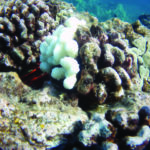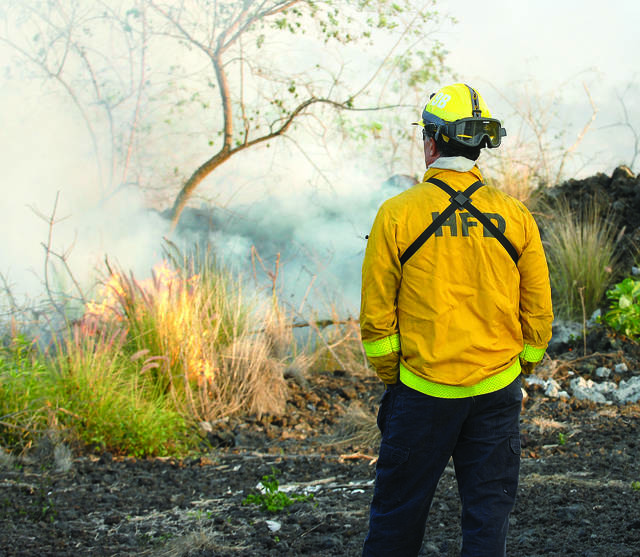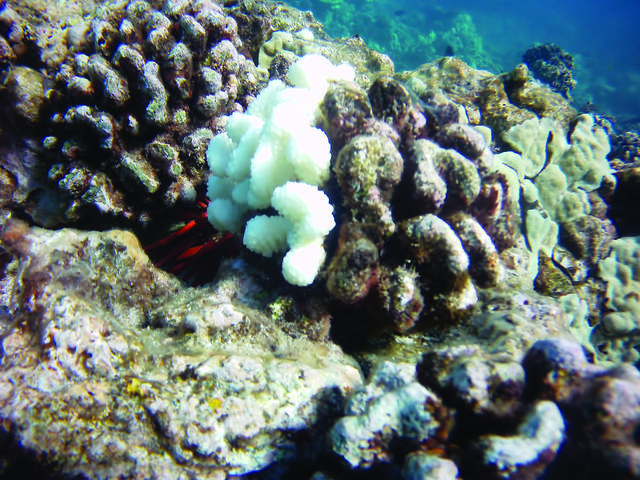KAILUA-KONA — There’s a high probability an El Nino will form and persist through the winter and spring, bringing with it threats to corals and farming concerns as well as an increased risk of wildfires.
The presence of El Nino manifests in myriad weather irregularities including warmer ocean temperatures, less rainfall and weakened trade winds in the winter, as well as a higher likelihood of tropical cyclones in the summer.
El Nino was only one of several factors, both natural and human-driven, that led to the extreme bleaching event of 2015. But Lindsey Kramer, habitat and fish monitoring coordinator for the state’s Division of Aquatic Resources on Hawaii Island, said the weather phenomenon played a significant role in the bleaching and ultimate death of roughly 90 percent and 50 percent of West Hawaii corals, respectively.
“The (El Nino) predictions for 2019 aren’t a good sign for coral bleaching for the upcoming year,” she said.
Following a four-year bleaching period between 2014-17, last year saw West Hawaii come under a coral reef bleaching watch as waters approached threshold temperatures and held elevated temperatures for a duration of several weeks.
Corals throughout the region are progressing and regressing at separate rates since the catastrophic conditions that defined the middle years of the decade. It remains unclear just how much havoc another bleaching event might wreak.
“In places the coral are very gradually recovering, (while) at other sites we’ve seen continued decline in coral cover,” Kramer explained.
There’s little effective response to manage an acute bleaching crisis, as solutions to climate change and greenhouse gas emissions require national and international action and collaboration over a period of several years.
Kramer said the best thing the public can do to protect corals in the near term is support local legislation to develop more marine protected areas and combat local stressors like watershed issues, sedimentation and cesspool pollution.
El Nino has more than one impact on water. It doesn’t just heat it up, it changes how much falls from the sky and when.
Matthew Foster, meteorologist with the National Weather Service in Honolulu, said NWS has forecast a 90 percent chance of El Nino in the winter and a 60 percent chance it persists into the spring.
According to North Ops Predictive Services, rainfall totals are projected below normal levels from December through the spring months assuming an El Nino takes hold and hangs around.
Because of this, and despite rainfall through last summer and fall that left green grass crop in several areas across the state, large fire potential is expected to increase to above normal levels from January to March.
“December was still neutral conditions,” Foster said, “(But) it would be expected drier than normal over the next few months.”
New Year’s Eve and Day were jointly characterized by three separate blazes in West Hawaii alone, two in the area of Waikoloa Village and one above Hawaiian Homes in Kawaihae.
A Wednesday release from Andrea Kawabata, an extension agent with University of Hawaii College of Tropical Agriculture and Human Resources in West Hawaii, warned farmers in the region to prepare for the possibility of drought conditions through spring.
“A lack of rain/irrigation could cause fruits and nuts to abort or lack in size, juice and flavor,” the release read. “In severe conditions, trees may need to be provided irrigation to avoid tree losses. Watch for added pest and disease pressure resulting from tree stress and treat as needed.”
The National Oceanic and Atmospheric Administration has advised water managers to expect a minor decrease in the availability of surface water, resulting in a greater need for groundwater.
Foster also confirmed El Nino conditions threaten to make tropical cyclones more prevalent during hurricane season, which spans the months of June to November.
The first storms of the season are likely to form near Mexico in May, he explained. The water stretching across the equatorial Pacific Ocean to Hawaii isn’t likely to have warmed enough by that time to allow those first storms forming in Mexico to cross all the way to the islands in tact.
As the season progresses and waters continue to warm, however, the likelihood of tropical cyclones forming and holding strong becomes more prevalent.







So Lindsey Kramer wants you to support more marine “Protection” areas. Sure, let the state government of Hawaii control more of the ocean (roll eyes). Government is at best, inept at most things they do. What is the government going to do with this protection? Most likely prevent Hawaiians from fishing, swimming, and boating in these areas. How does that stop El Nino? How does that stop Hurricanes? WAKE UP PEOPLE! This is just another excuse for the government to control more of life and liberty as humans by taking away our right to access the ocean.
What would work? OK, I agree with the cesspool watershed issues. This is one area where the government can make an impact. Enforce a best practice building code for sanitation by requiring all NEW construction to have effective waste management using septic with sufficient size settling and leach field. Develop a comprehensive plan for sewage treatment facilities where practical.
We can’t (and shouldn’t try) to stop the population from growing, from people building shelter and instituting commerce. What the government can do to help is legislate the growth to use best practice methods for building and waste management when entering areas that are undeveloped. People will innovate in order to meet requirements. People will rebel when their use of land and sea are stopped.
I think we all agree on the cesspool issue and as you say this is common sense legislation that is unfortunately the exception rather than the norm here.
Regarding the protected marine areas and recreational fishing licences etc.. There is just to much of other peoples money and lifestyle to be had. If you rely on a government job and resources like this Lindsy person your objective is to control access to god given resources (in the name of protection of course) then charge people for access so that you can have your cushy retirement.
If Ms Kramer were serious about making a difference she would be going after the long line fishing industry which is in collusion with the DLNR. The long liners are absolutely plundering our aquatic resources with foreign fisherman and shipping our fish to other countries at $2 lb while we have 20% of our people on SNAP benefits! This make absolutely no economic or environmental sense.
We should ‘stop the population from growing’ and soon. Over population is the root cause of all the worlds problems starting with global warming. Having more than two children is irresponsible. Seven billion people and counting.